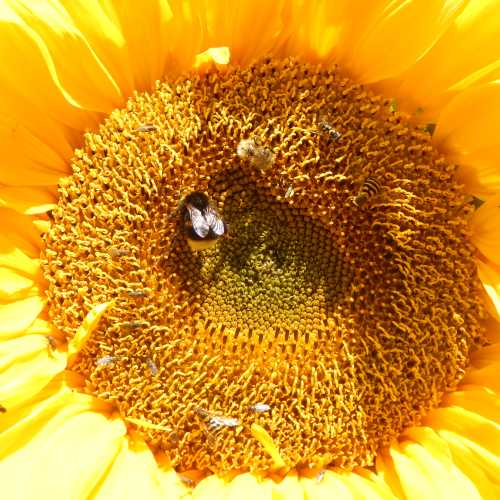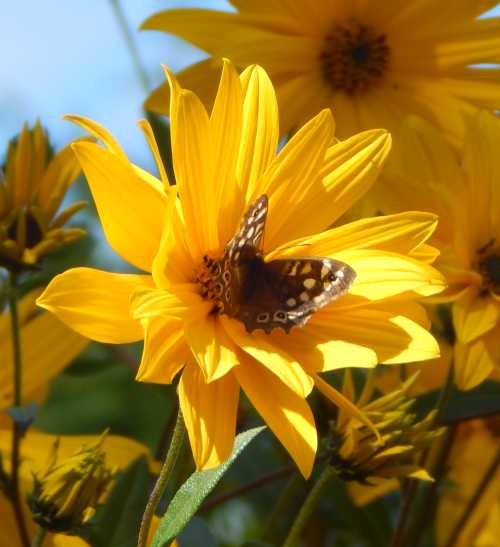Everyone Knows Bees Like Sunflowers
Everyone knows that bees like sunflowers. Humans love them too, and they are a particular favourite among children.
Indeed, I'm sure almost everyone knows what they look like. Ask anyone to draw a picture of a
sunflower, and 9 - if not 10 times out of 10, they'll draw one of the tall, thick-stemmed,
large-headed, cheery-faced gangly specimens we are all familiar with.
Next time you come across these wonderful, large-headed sunflowers, take a good look at the centre of the flower head. It's not only bees that love sunflowers, hover flies and all manner of other little flies and tiny beetles are likely to be present, sharing in the feast of pollen and nectar.
Thanks to pollination by the bees and other insects, the magnificent heads will begin to bear fruit in the form of seeds that are much appreciated by birds, especially finches.
 Everyone knows that bees like sunflowers.
Everyone knows that bees like sunflowers.
Sunflowers are also known as Helianthus.
Of course, among the tall varieties, the bright yellow blooms are perhaps the most commonly seen and grown. I recall as a child taking part in a youth club sunflower growing competition. Such competitions are still popular today.
I dutifully planted 5 black and white striped seeds (provided by the youth club), and tended them carefully, potting them outside when they were sufficiently strong and sturdy. We were allowed to enter one of the plants from the 5 seeds into the competition.
The day came for one of the organisers to measure my sunflower. It had grown quite tall, and had the lovely yellow petals and sunshine face we are all familiar with. I actually got third prize in the competition, and the prize was a chocolate bar. I
was about 7 years old, and I was very pleased!
 Take a good look at the centre of the flower head. It's not only bees that love sunflowers, hover flies and all manner of other little flies and tiny beetles are likely to be present.
Take a good look at the centre of the flower head. It's not only bees that love sunflowers, hover flies and all manner of other little flies and tiny beetles are likely to be present.Many sunflowers suit many bees and pollinators!
Of course, sunflowers are available in shades other than the bright yellow favourite. Shades through to rusty brown and red-blushed deep yellows are available, along with compact dwarf varieties.
 Shades through to rusty brown and red-blushed deep yellows are available.
Shades through to rusty brown and red-blushed deep yellows are available.
However, my favourite of all sunflowers for growing in the garden are the willowy yet sturdy stemmed perennial sunflowers.
In my experience, these lovely Helianthus are as attractive as their stouter cousins to bees, butterflies and other pollinators such as hover flies.
 Speckled wood butterfly on Helianthus.
Speckled wood butterfly on Helianthus.
I
was first given a small clump of rhizomatous
root growth several years ago, which I planted in the
garden. I have moved it around several
times, split it up and given a portion to a neighbour. However, the plant is now
in its permanent position at the back of the border.
 Common carder bumble bee and hover fly on perennial Helianthus.
Common carder bumble bee and hover fly on perennial Helianthus.
The
photographs I have here (not all of them from my garden) are of Helianthus x 'Lemon Queen', and it grows
4-6 feet tall. In my garden, it’s
at the 6ft mark with just a few shorter stems, and like other sunflowers of its
type, it brings welcome vibrancy to the flower border, in addition to providing food
for pollinators from late summer to autumn.
 There's still room for 2 on a Helinathus - perennial sunflower. This is 'Lemon Queen'.
There's still room for 2 on a Helinathus - perennial sunflower. This is 'Lemon Queen'.
This is the period of
time when new bumble bee queens will need to feed vigorously to lay down fat to
see them through the winter.
In addition, some of the later bumble bee workers (depending on the summer and time of flower) may still be out foraging for a colony that hopefully by now will be at its peak, perhaps focusing its efforts on rearing males and new queens.
Honey bees also
appreciate the lovely blooms, along with butterflies, hover flies, and various
other flies and small beetles. Patches
of Helianthus, Lemon Queen, hum and buzz with activity from pollinators of various types.
 Honey bees also like sunflowers.
Honey bees also like sunflowers.
Similar specimens
include Helianthus angustifolius which has brown-purple centres, and can also
reach 6 ft.
Even taller varieties
are available, for example Helianthus maximiliani is one of the tallest perennial sunflowers, and
can reach up to 10 feet tall! It’s
perfect for a very wide border that needs both height, and brings sunshine
yellow and even better – bees and butterflies to the garden.
If you love the cheerful flowers but don’t have space for a tall
specimen, then at the opposite end of the scale, do look up compact Helianthus varieties.
 These tall sunflower varieties bring vibrancy, cheer and pollinators to the back of the border.
These tall sunflower varieties bring vibrancy, cheer and pollinators to the back of the border.
Growing and caring for Helianthus
If you are planting one of the stout, tall varieties, you can start them
off indoors or outdoors from seed. Outisde, ensure the plants are about 1 foot apart. They obviously need a sunny spot and access
to deep soil so the roots can support the tall plant.
You may need to provide plant supports if you live in an area prone to strong
winds.
The seed heads can be left for the birds.
For the perennial types described, plant your root growth in a sunny spot. After flowering, you can cut the stems right back. This is a good time to divide clumps if yours is large enough, and give some to the local school or neighbours.
 Helianthus 'Lemon Queen' at the rear of the flower border. In the foreground, Rudbeckia and Echinops
Helianthus 'Lemon Queen' at the rear of the flower border. In the foreground, Rudbeckia and EchinopsMore articles about bees, flowers and gardening
- 30 Fantastic Garden Flowers For Bees 30 Fantastic Garden Flowers For Bees - recommendations for the perfect bee garden
- 20 Flowering Shrubs For Bees 20 Flowering Shrubs For Bees: wonderful tried and tested flowering shrubs loved by bees and other pollinators.
- Which Roses Do Bees Like? Which Roses Do Bees Like? Bees typically like the beautiful open flowers of wild roses and rosa rugosa (commonly called beach rose)
- Herb Planting For Bees Herb planting for bees: a list of herbs loved by bees, butterflies and other pollinators.